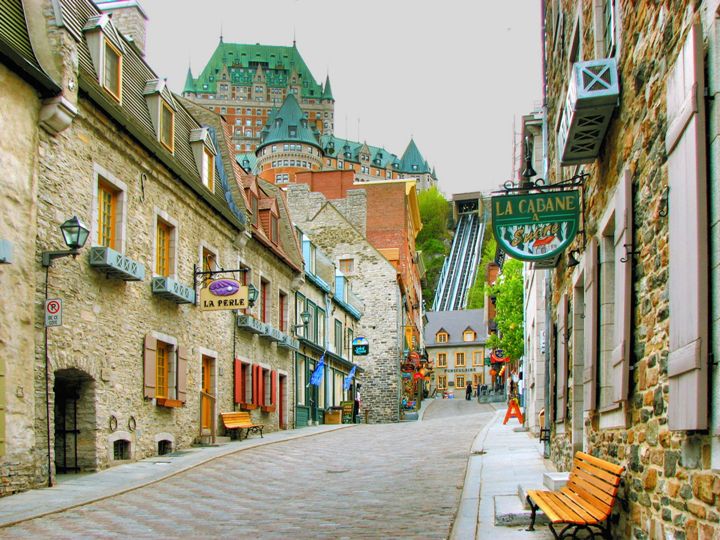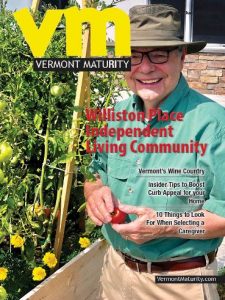
As I flew into Quebec City in late March, I thought of my father, who was French Canadian and born in the small town of Chateauguay in the province of Quebec. He was proud of his heritage and every few years would drive us 300 miles from our Massachusetts home, across into Vermont, through upstate New York, around Lake Champlain and across the St. Lawrence River to visit his boyhood home. I loved visiting the farm where he was born and, remarkably, the shed where he was actually born was still standing on the property.
We would feed the livestock and chickens, milk the cows, make cheese, tend the fields and dine on vegetables, eat the honey from the hives on our morning toast and marvel at the imperial quarts of milk delivered by horse-drawn carts through the streets of Montreal and Quebec City. They were bigger than those in the United States, with a bulging neck that would collect the cream for the adults’ coffee.
Then there was the delicious honey butter that came in crocks and also graced the toast when we dined with our big-city relatives in Montreal. The distinctive flavor of fresh-pressed cider from Macintosh apples and the maple syrup and candies have a special place in my memory.
My father loved hockey and golf, the major Canadian pastimes. He was good at them both and played on the Boston University team before World War II interrupted his education. The last time I had visited the city I was 16. College would interrupt my return for many more years.
When I landed, the city had just gone through a very mild winter and the previous week temperatures had reached into the 70s. Alas, when I arrived, temperatures plunged into the teens and brave new buds were shivering in the cold along with me. It even snowed on my final day in the city.
My memories of Quebec City were dim. I remembered wandering the narrow and enchanting streets of Old Town (Vieux-Quebec), now a UNESCO World Heritage Site composed of Basse-Ville (Lower Town) and High Town (Haute-Ville). The period architecture dates back 400 years and reminds one of Europe, especially with the sounds of French floating in the air.
I remembered the Marche, where the local farmers sold their goods on the weekends, and the immensity and utterly stunning beauty of The Chateau Frontenac, perched above the city wall (the only one still standing in North America) next to the cannons and gunnery placements that guarded this narrowing of the St. Lawrence River. This area was crucial in the fighting between the English and French for control of the Canadian Territory and entry into the Great Lakes and mid-America. According to local lore, it is the most photographed hotel in the world.
The British may have won the battle that ceded them the country, but they could not pry the language or the heritage from French Canada. The name Quebec is not French, however. It is derived from the Algonquin language and means “narrowing of the river.”
Mayor Regis Labeaume has made revitalization of the working-class Saint-Roch neighborhood a priority, pouring money into redevelopment. New galleries, restaurants, clubs and shops have turned it into one of the chicest locations in town. Cirque du Soleil has set up headquarters here and offers free shows in the summer. Saint-Roch Church is the largest in Quebec City and the focal point of the community.
The best way to get a full view of this city of just over 500,000 is to take the ferry across the St. Lawrence River to Levis. The ancient skyline reveals itself upon the promontory, and the Frontenac’s full majesty is impressive. When I returned to the dock, I took a walking tour of Old Town, both lower and upper. For only $1.50, it’s possible to ride on the Old Quebec Funicular up to Haute-Ville, a relatively compact town that can be covered in a few hours at a leisurely pace. The buildings and town squares are distinct and lovely, and the narrow lanes make for great window shopping.
The Musee des Beaux-Arts is on the grounds of the Plains of Abraham battlefield (1759) that determined British dominion over Canada and the end of French colonization. In the 1763 Treaty of Paris, the territory was officially ceded to England for good.
I enjoyed La Korrigane brewpub on Dorchester Street, where I asked for the five-glass taster so I could enjoy the range of beers from a fresh blueberry lager to a dark chocolate stout. And speaking of chocolate, the sweetest part of the city tour is a visit to 634 rue Saint-Jean and the Chocolate Museum .
One of the more unusual shops was Benjo, a toy store on steroids with a staff of grown-up 10-year-olds who love teasing the customers. Here a zany train ride takes visitors around the store and through the tunnel into a back-room fantasyland. I was also surprised by the employee-operated flying sharks and darting toy helicopters as well as the 5-foot robot who loved to squirt water on shoppers.
The hockey-mad city is building a $400 million sports complex to try and lure a new club to replace the Nordics, who left for Denver a few years ago.
About seven miles northeast of Quebec City are the thundering Montmorency Falls, named by explorer Samuel de Champlain for his patron, the Duke of Montmorency. At 227 feet tall, they are the tallest in North America and nearly 100 feet higher than Niagara Fall, but far narrower. For the brave of heart, there is a footbridge that spans the falls with spectacular views. In winter, snowboarders make use of the spray from the falls that coats the nearby rocks with continuously falling powder snow. There are also a number of excellent ski resorts within an hour of town.
Visiting Quebec City again after so many years brought back a flood of memories to me, and first-time visitors are in for a real treat.
When You Go
For housing options, restaurant information, shopping tips, event listings, guidebooks, brochures and maps, contact the Quebec City Tourist Office 877-783-1608 or www.quebecregion.com.
I stayed at the new TRYP Quebec Hotel PUR in the Saint-Roch District. My favorite area was the spa, with a dry sauna to chase the winter cold, a large lap pool and exercise room.
Restaurant Table, Bar Gastronomique is run by inventive young chef Francois Prive. The restaurant kitchen is in the center of the room surrounded by well-spaced tables that allow easy conversation. Food is eclectic, seasonal, creative and often on small plates.
This article was contributed by John Blanchette.
 Related Articles & Free Subscription
Related Articles & Free Subscription
Thrifty Travel: How to Find Inexpensive Travel Accommodations






Comment here